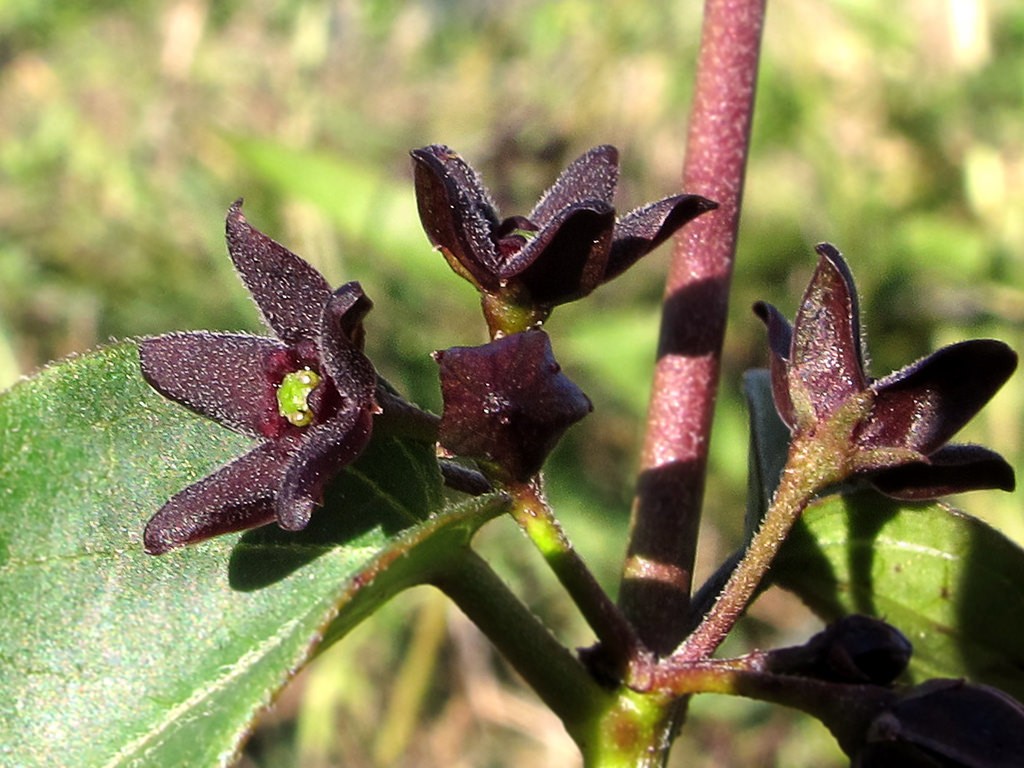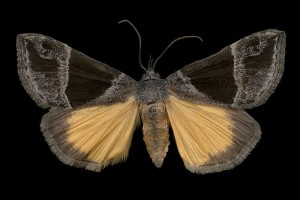Dog strangler chokes on caterpillar

Black swallow-wort or “dog-strangler vine” in bloom. Photo: Jacinta Lluch Valero, Creative COmmons, some rights reserved.
The invasive plant our Canadian neighbors call dog-strangling vine doesn’t harm pets, but it lives up to its name as a strangler, choking out native wildflowers as well as forest understories, Christmas tree plantations, and hay fields. Its canine-throttling moniker isn’t just a nickname—its genus name, Cynanchum, actually means dog strangler.
Better known in the U.S. as swallow-wort, biologists and agronomists have been losing sleep over this Eurasian native. While there are two species, pale and black swallow-wort, they cause the same problems and are often found growing together, so it only makes sense to lump the two together.
It is a twining perennial vine with glossy lance-shaped leaves growing opposite one another on the vine. It’s actually in the milkweed family, and has seed pods similar to those of milkweed, though much more slender.
Swallow-wort thrives in almost any soil type and has a prodigious root system that is toxic to other plants. It quickly forms dense monocultures that, in some cases, become hundreds of acres in size. Wait—there’s more. Dog-strangling vine is so poisonous that no North American bird, mammal, or insect will eat it. But because it’s a relative of milkweed, monarch butterflies will lay eggs on its leaves. The unfortunate result of this is their caterpillars die after consuming swallow-wort. It is unusually good at making and dispersing seeds, and it bounces back from most herbicides.
So it’s with much relief that researchers at the University of Rhode Island announced they’ve recently located and vetted a worthy opponent. While swallow-wort has withstood mowers, rototillers, flame throwers (true) and potent agrochemicals, it’s no match for this brute. At a tenth the weight of a paper clip and a fraction of an inch long, our hero is Hypena opulenta, the larva of a Ukrainian moth.
In its native range, swallow-wort is just another well-behaved native plant because the tiny green Hypena opulenta caterpillar, along with other insects, keep it in check. In fact, Carleton University biologist Naomi Cappuccino, a Canadian researcher who went to Ukraine with URI scientists to look for biological controls, said they had a hard time locating any swallow-wort; it was that scarce.
Finding biological controls for an exotic invasive plant is no easy task, and requires traveling to the plant’s home environment to make field observations in all kinds of conditions. But once an insect, pathogen or vertebrate is identified, the real work begins.
Many years of quarantine with carefully controlled trials are required to make sure a potential hero won’t end up going over to the Dark Side and doing more harm than good, which has happened in the past. Cane toads, imported to Australia as a supposed beneficial, have become a plague of Biblical proportion there, disrupting ecosystems in ways never imagined by those who introduced them.

The larva of the Hypena opulenta moth found in the Ukraine is an effective bio-control for invasive swallow-wort. Photo: Jeen123, Creative Commons, some rights reserved
Our would-be champion caterpillar isn’t yet approved for release in the U.S., but in Canada 500 Hypena opulenta larvae were released near Ottawa in September 2013 in a cold-hardiness trial, which they passed. The hope is we’ll have a success story like the recent one with purple loosestrife, in which biological controls stopped it from taking over freshwater wetland ecosystems. Even if Hypena opulenta performs admirably, it may be a decade or more before we see the decline of the dog-strangler.
To paraphrase Princess Leia, “Help us, Hypena opulenta; you’re our only hope.” (Thus far, at least.)
Paul Hetzler is a horticulture and natural resources educator with Cornell Cooperative Extension of St. Lawrence County.







